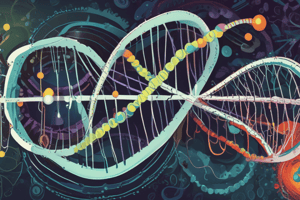Podcast
Questions and Answers
What is the role of the centromere in chromosomes?
What is the role of the centromere in chromosomes?
- Vital function in cell division (correct)
- Storage of genetic information
- Synthesis of proteins
- Regulation of gene expression
What is the application of nanopore sequencing in clinical environments?
What is the application of nanopore sequencing in clinical environments?
- Identifying pathogens (correct)
- Synthesizing proteins
- Studying gene expression
- Detecting genetic mutations
What is the focus of pharmacogenomics?
What is the focus of pharmacogenomics?
- Analysis of gene variation and drug response (correct)
- Development of new drug delivery methods
- Study of drug side effects
- Investigation of disease pathology
What is the goal of pharmacokinetics?
What is the goal of pharmacokinetics?
What is the role of single nucleotide variant (SNV) panels in pharmacogenomics?
What is the role of single nucleotide variant (SNV) panels in pharmacogenomics?
What is the application of nanopore sequencing in the Ebola outbreak?
What is the application of nanopore sequencing in the Ebola outbreak?
What is the focus of pharmacodynamics?
What is the focus of pharmacodynamics?
What is the goal of pharmacogenomics analysis?
What is the goal of pharmacogenomics analysis?
What is the significance of the centromere in cancer formation?
What is the significance of the centromere in cancer formation?
What is the role of long-read sequencing in pharmacogenomics?
What is the role of long-read sequencing in pharmacogenomics?
Flashcards are hidden until you start studying
Study Notes
Definition and Scope of Pharmacogenomics
- Pharmacogenomics (PGx) is the study of the role of the genome in drug response.
- It combines pharmacology and genomics to analyze how a patient's genetic makeup affects their response to drugs.
- PGx deals with the influence of acquired and inherited genetic variation on drug response, correlating DNA mutations with pharmacokinetic and pharmacodynamic endpoints.
History of Pharmacogenomics
- The first PGx dose recommendations for antidepressant and psychiatric drugs were published in 2001.
- The field has grown, making more thorough dosing guidelines and genotyping techniques necessary.
Technologies Applied in PGx Research
Next Generation Sequencing (NGS)
- NGS is a powerful tool to identify genetic variants and variable gene expression patterns that correlate with disease states and provide clinically relevant mechanistic insights.
- The NGS workflow involves four steps: sample extraction, library preparation, sequencing, and analysis.
Next Generation Sequencing (NGS) Workflow
- Step 1: Sample extraction - involves extracting DNA or RNA from samples such as cell cultures, tissues, blood, saliva, or bone marrow.
- Step 2: Library preparation - involves template amplification, PCR amplification, and primer design based on sequences of interest.
Long-read Sequencing
- Long-read sequencing is a DNA sequencing technique that determines the nucleotide sequence of long sequences of DNA (10,000 to 100,000 base pairs).
- It has been shown to be capable of reading even 1-2 million base pairs at a time.
- Long-read sequencing is useful for resolving repeated sequences and detecting structural variants.
Long-read Sequencing Technologies
- Oxford Nanopore sequencing
- PacBio single-molecule real-time (SMRT) sequencing
SMRT Sequencing
- SMRT sequencing works by detecting different levels of fluorescence generated when a target DNA sequencing is replicated with modified nucleotides.
- It uses thousands of tiny pores called zero-mode waveguides (ZMWs) to detect the incorporation of nucleotides in real-time.
Nanopore Sequencing
- Nanopore sequencing measures changes in ionic current when single-stranded DNA fragments move through a nanopore.
- Different DNA sequences produce different levels of resistance, allowing for exact nucleotide sequence determination.
Advantages of Long-read Sequencing
- More accurate than other techniques, especially for repeated sequences and structural variants.
- Useful for detecting copy number variations, such as in Huntingdon's disease.
Applications of Long-read Sequencing
- Accurate mapping of the human Y chromosome centromere.
- Rapid detection and identification of pathogens in clinical environments.
- Monitoring and tracking of epidemics, such as Ebola.
Studying That Suits You
Use AI to generate personalized quizzes and flashcards to suit your learning preferences.




